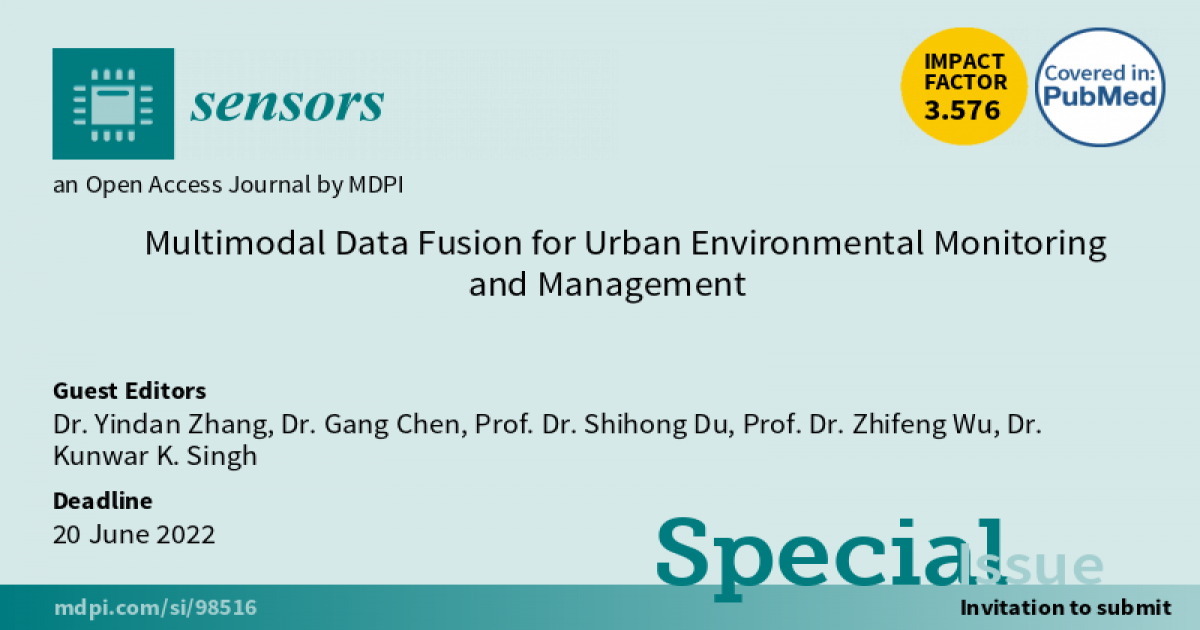Multimodal Data Fusion for Urban Environmental Monitoring and Management
A special issue of Sensors (ISSN 1424-8220). This special issue belongs to the section "Radar Sensors".
Deadline for manuscript submissions: closed (20 June 2022) | Viewed by 13744

Special Issue Editors
Interests: object-based image analysis (GEOBIA); artificial intelligence (e.g., deep learning) for remote sensing image interpretation; geospatial data mining and understanding; remote sensing of urban environment
Interests: remote sensing; forest disturbances; GEOBIA; spatial ecology
Special Issues, Collections and Topics in MDPI journals
Interests: image classification; spatial analysis; deep learning; sample learning; urban landscape
Special Issues, Collections and Topics in MDPI journals
Interests: urban ecology; natural resource; remote sensing; GIS
Special Issues, Collections and Topics in MDPI journals
2. Center for Geospatial Analysis, College of William and Mary, Williamsburg, VA 23185, USA
Interests: geospatial analysis of land and vegetation dynamics; vegetation (forest and crop) phenology; invasive plant light detection and ranging; drones
Special Issues, Collections and Topics in MDPI journals
Special Issue Information
Dear Colleagues,
The causes and pressures of the majority of today's environmental problems can be traced back, directly or indirectly, to urban areas. The forces and processes that constitute "urban activity" have far-reaching and long-term effects on its immediate boundaries and the entire region in which it is positioned. Over recent decades, Earth Observation (E.O.) for urban areas has become an essential means of characterizing urban sprawl, monitoring the consequences of anthropogenic activities within cities, and offering critical findings to assist urban researchers or managers in making informed decisions. With enhanced E.O. capabilities, remote sensing data from multiple platforms, multiple sensors, and multiple dates are becoming ubiquitous. Advanced physical and machine learning models have facilitated multimodal data integration for urban environmental studies with promising results. However, the unification of information for urban applications remains challenging due to (i) finding appropriate information fusion strategies that can adapt to various urban environments being difficult and (ii) balancing big data analytics and information needs for dealing with specific environmental issues is tricky.
This Special Issue invites submissions on the latest advances in multimodal data fusion for mapping and monitoring the urban environment. The focus of the contributions to the Special Issue will be on reviewing current progress, highlighting the latest methodologies proposed to respond to the needs of multimodal data processing for urban environmental monitoring and management, and pointing out the strategies that may meet the requirements of potential applications.
The topics of interest include (but not limited to):
- Novel, computationally efficient algorithms for the processing and fusion of data from multi-sensors, multi-sources, and multi-temporal acquisitions;
- New methodologies, e.g., data registration, efficient processing for complex, big data, data quality assurance/pre-processing, deep learning, etc., for urban environment monitoring and management;
- Innovative applications for urban change detection, LCLU mapping, disaster monitoring, responses, etc.;
- Interdisciplinary and higher-level studies on various aspects of employing multimodal data fusion such as feasibility, strength, challenges, and effectiveness.
Dr. Yindan Zhang
Dr. Gang Chen
Prof. Dr. Shihong Du
Prof. Dr. Zhifeng Wu
Dr. Kunwar K. Singh
Guest Editors
Manuscript Submission Information
Manuscripts should be submitted online at www.mdpi.com by registering and logging in to this website. Once you are registered, click here to go to the submission form. Manuscripts can be submitted until the deadline. All submissions that pass pre-check are peer-reviewed. Accepted papers will be published continuously in the journal (as soon as accepted) and will be listed together on the special issue website. Research articles, review articles as well as short communications are invited. For planned papers, a title and short abstract (about 250 words) can be sent to the Editorial Office for assessment.
Submitted manuscripts should not have been published previously, nor be under consideration for publication elsewhere (except conference proceedings papers). All manuscripts are thoroughly refereed through a single-blind peer-review process. A guide for authors and other relevant information for submission of manuscripts is available on the Instructions for Authors page. Sensors is an international peer-reviewed open access semimonthly journal published by MDPI.
Please visit the Instructions for Authors page before submitting a manuscript. The Article Processing Charge (APC) for publication in this open access journal is 2600 CHF (Swiss Francs). Submitted papers should be well formatted and use good English. Authors may use MDPI's English editing service prior to publication or during author revisions.
Keywords
- multimodal
- data fusion
- urban remote sensing
- land-cove and land-use (LCLU) mapping
- change detection
- disaster monitoring and responses
- data assurance/pre-processing
- deep learning
Benefits of Publishing in a Special Issue
- Ease of navigation: Grouping papers by topic helps scholars navigate broad scope journals more efficiently.
- Greater discoverability: Special Issues support the reach and impact of scientific research. Articles in Special Issues are more discoverable and cited more frequently.
- Expansion of research network: Special Issues facilitate connections among authors, fostering scientific collaborations.
- External promotion: Articles in Special Issues are often promoted through the journal's social media, increasing their visibility.
- Reprint: MDPI Books provides the opportunity to republish successful Special Issues in book format, both online and in print.
Further information on MDPI's Special Issue policies can be found here.










